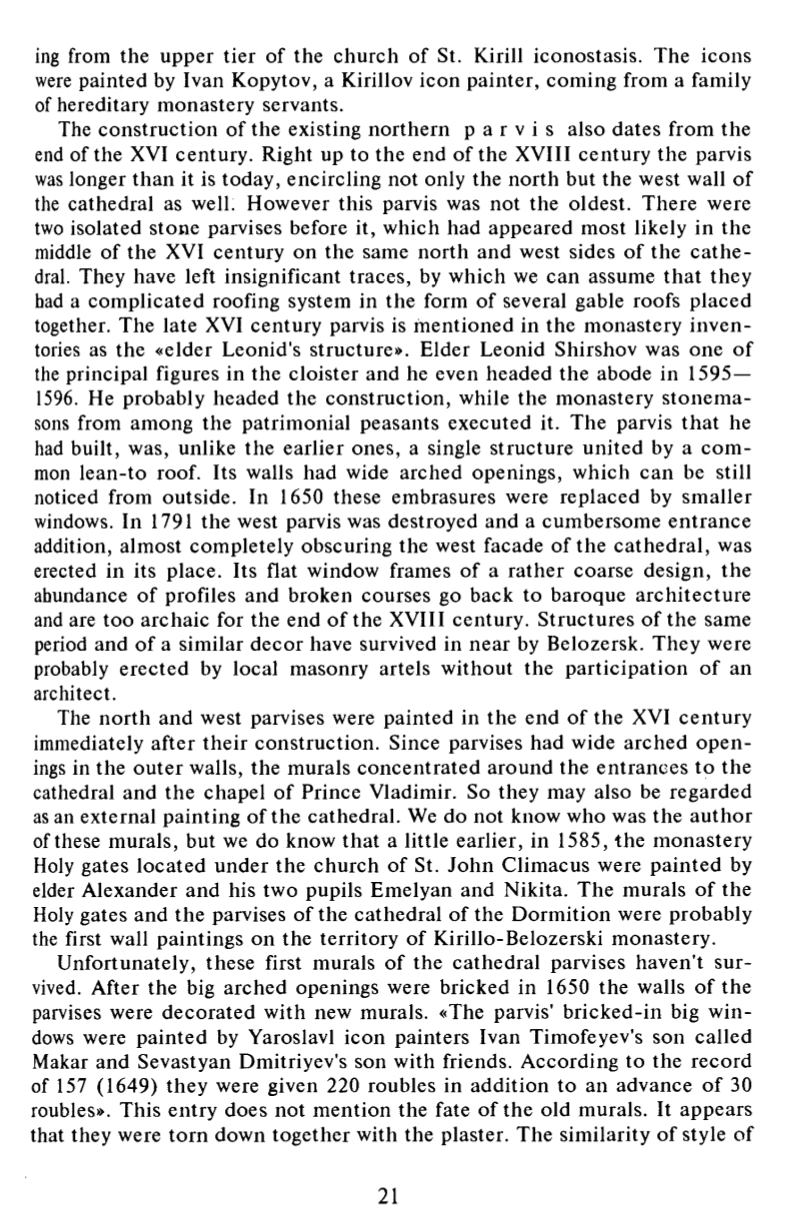

ing from the upper tier of the church of St. Kirill iconostasis. The icons
were painted by Ivan Kopytov, a Kirillov icon painter, coming from a family
of hereditary monastery servants.
The construction of the existing northern p a r v i s also dates from the
end of the XVI century. Right up to the end of the XVIII cen tury the parvis
was longer than it is today, encircling not only the north but the west wall of
the cathedral as well. However this parvis was not the oldest. There were
two isolated stone parvises before it, which had appeared most likely in the
middle of the XVI century on the same north and west sides o f the c a th e
dral. They have left insignificant traces, by which we can assume th a t they
had a complicated roofing system in the form of several gable roofs placed
together. The late XVI century parvis is men tioned in the monastery inven
tories as the «elder Leonid's structure». Elder Leonid Shirshov was one o f
the principal figures in the cloister and he even headed the abode in 1595—
1596. He probably headed the construction, while the monastery s ton em a
sons from among the patrimonial peasants executed it. The parvis tha t he
had built, was, unlike the earlier ones, a single structure un ited by a c om
mon lean-to roof. Its walls had wide arched openings, which can be still
noticed from outside. In 1650 these embrasures were replaced by smaller
windows. In 1791 the west parvis was destroyed and a cumbersome en trance
addition, almost completely obscuring the west facade of the cathedral, was
erected in its place. Its flat window frames of a rather coarse design, the
ahundance o f profiles and broken courses go back to baroque a rch itecture
and are too archaic for the end o f the XVIII century. Structures o f the same
period and o f a similar decor have survived in near by Belozersk. They were
probably erected by local masonry artels without the participation o f an
architect.
The no rth and west parvises were painted in the end o f the XVI cen tury
immediately after their construction. Since parvises had wide arched o p e n
ings in the ou ter walls, the murals concen trated around the en trances to the
cathedral and the chapel o f Prince Vladimir. So they may also be regarded
as an external painting of the cathedral. We do not know who was the au tho r
of these murals, but we do know that a little earlier, in 1585, the monastery
Holy gates located under the church of St. John Climacus were pa in ted by
elder Alexander and his two pupils Emelyan and Nikita. The murals o f the
Holy gates and the parvises of the cathedral of the Dormition were probably
the first wall paintings on the territory of Kirillo-Belozerski monastery.
Unfortunately, these first murals o f the cathedral parvises haven't su r
vived. After the big arched openings were bricked in 1650 the walls o f the
parvises were decorated with new murals. «The parvis’ bricked-in big w in
dows were pain ted by Yaroslavl icon painters Ivan Timofeyev’s son called
Makar and Sevastyan Dmitriyev's son with friends. According to the record
of 157 (1649) they were given 220 roubles in addition to an advance o f 30
roubles». This entry does not men tion the fate of the old murals. It appears
that they were to rn down together with the plaster. The similarity o f style of
21















